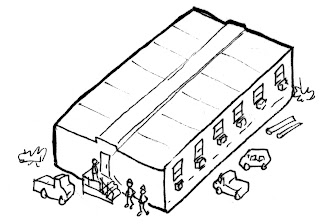Man Camp
Time period: 2010s to present
Location: North Dakota and other oil fields
Portable dorms and apartments for oil field workers
Key features
- Modular building made up of sections that can be transported by truck
- Usually built in large complexes housing 100-2,000 workers, with dining halls, laundry, gyms, medical clinics, and other amenities
Starting in the 2000s, high oil prices made hydraulic fracturing - also known as fracking - profitable in many parts of the United States. This process involves drilling lots of wells and pumping high-pressure liquid to crack the rock, releasing oil and gas. Fracking helped relieve the energy crisis, but also created a housing crisis.
Once an oil field was discovered, fracking the oil required a lot of workers - but only temporarily. Existing hotels and housing in remote oil field towns could not meet the demand, and were a long drive from the drill sites. Building new apartments was also challenging since anyone who might otherwise work construction had left for a higher-paying oil job, and on top of that, oil fields have a limited lifespan, which meant that someone investing in new apartments might not have enough time to make back their costs before demand disappeared. Some tried anyway and were left holding the bag with vacant buildings when the boom turned to bust in less than ten years.
Instead, oil workers moved into man camps. These are basically very large mobile homes, made up of modules built elsewhere and trucked in. Modules are typically around 12 feet wide and 50 feet long, as sizes larger than that are expensive to transport on highways. There are a few types of layouts:
- Bedrooms only, with bathrooms and dining down the hall
- Bedrooms with private or semi-private bathrooms, shared dining halls
- Apartment style with a few bedrooms sharing a kitchen and bathroom
The rooms are arranged in long rows along a central hallway. To save costs, the hallway is a floor panel and roof panel bridging the gap between the room modules. Most man camps are single story, though some 2 and 3 story versions exist.
Example of a 100-person man camp. Typically about 1/4 to 1/3 of the building is shared amenities, with the rest being bedroom modules. In cold places such as North Dakota, everything is connected by indoor hallways, while in warm places such as Texas, the connections might just be a wooden sidewalk, or dirt. Building is surrounded by parking.
Built and operated by companies specializing in this type of housing, rooms in man camps are rented out directly to oil companies as employee housing, or rented out individually to workers.
Man camps have been controversial, though many of the issues have more to do with the sudden arrival of a large workforce of single men (while there are some women that live in man camps, the overwhelming majority of residents are men), and would have existed even with a different type of architecture.
While designed in theory to be portable and to be moved to the next oil field after the drilling is done, in practice, oil business booms and busts are on a national scale that follow the rise and fall of oil prices. As a result, when oil prices are low, there isn't a "next oil field" for an unused man camp to be moved to. Some have been put up on auction sites, while others are abandoned. Recently some governments have considered purchasing used man camp modules and bringing them to their city for use as low income housing.
Stats
- Density: around 20 rooms/acre (large parts of the lot are used for parking, drainage, etc)
- Typical Lot Size: 5-10 acres or more
- Typical Zoning: Rural.
- Construction Type: V (Portable wood frame)
- Resident Type: Rental, by the room
Where to build
- Rural areas with severe housing shortage, but lots of high paying jobs
- Within short drive of jobs, but not next to any existing residents
- Large flat site
Further reading
Interviews of man camp residents: https://www.nbcnews.com/id/wbna44375648
Research blog on man camps: http://www.northdakotamancamps.com/
Example of man camp floor plans: https://www.ramtechmodular.com/blog/project_category/commercial-man-camp/
Post-boom bust: https://finance-commerce.com/2015/09/man-camp-exodus-spurs-real-estate-crisis-across-u-s-shale-towns/
Man camps being reused as permanent affordable housing in Montana: https://www.ktvq.com/news/local-news/billings-group-utilizing-old-williston-man-camps-to-increase-affordable-housing-offered





Comments
Post a Comment